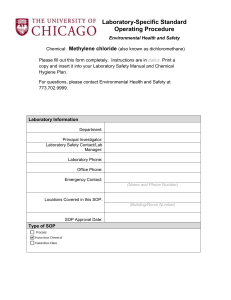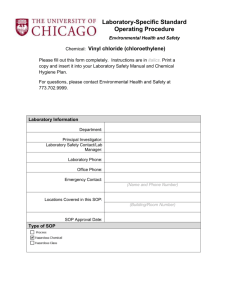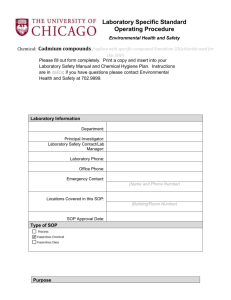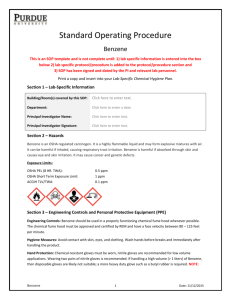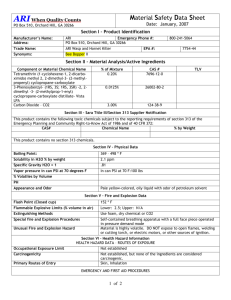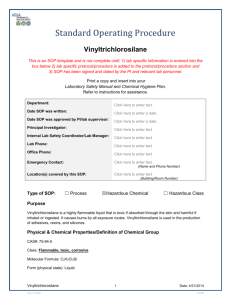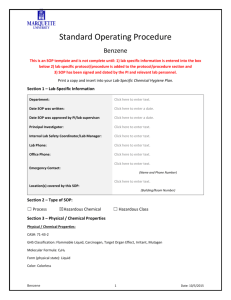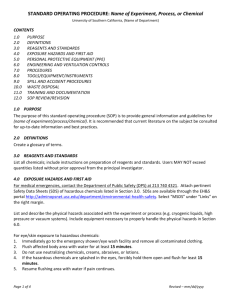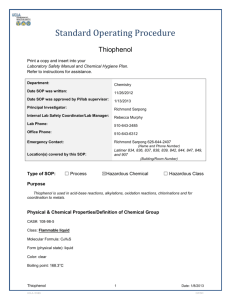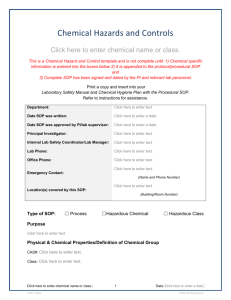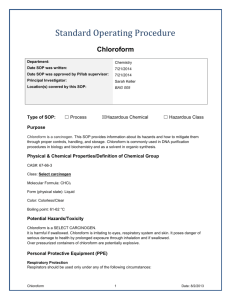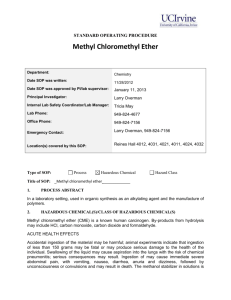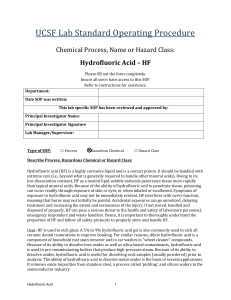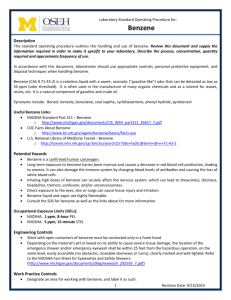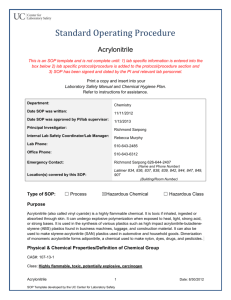Example SOP - Benzene - Environmental Health and Safety at the
advertisement
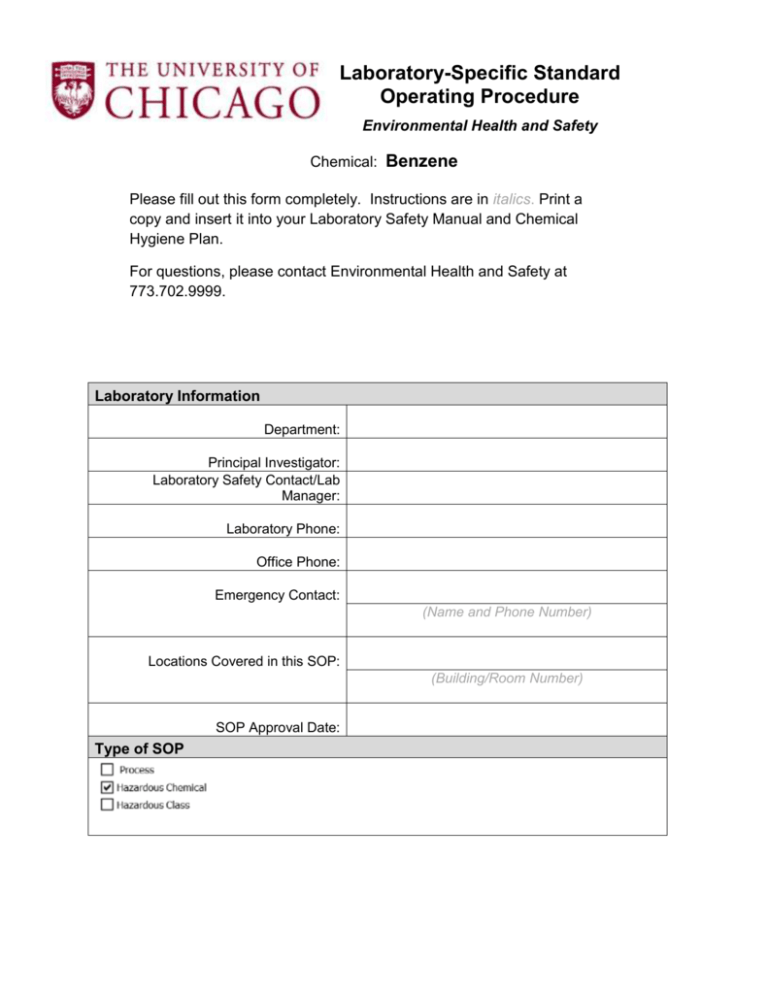
Laboratory-Specific Standard Operating Procedure Environmental Health and Safety Chemical: Benzene Please fill out this form completely. Instructions are in italics. Print a copy and insert it into your Laboratory Safety Manual and Chemical Hygiene Plan. For questions, please contact Environmental Health and Safety at 773.702.9999. Laboratory Information Department: Principal Investigator: Laboratory Safety Contact/Lab Manager: Laboratory Phone: Office Phone: Emergency Contact: (Name and Phone Number) Locations Covered in this SOP: (Building/Room Number) SOP Approval Date: Type of SOP Purpose (State the purpose and the procedure for the specific chemical that is used in the lab, include quantities and concentrations) Physical & Chemical Properties/Definition of Chemical Group CAS #: Emergency Overview: OSHA Hazards 71-43-2 Flammable liquid, Carcinogen, Target Organ Effect, Irritant, Mutagen Target Organs Blood, Eyes, Female reproductive system, Bone marrow GHS Classification Flammable liquids (Category 2) Acute toxicity, Oral (Category 5) Skin irritation (Category 2) Eye irritation (Category 2A) Germ cell mutagenicity (Category 1B) Carcinogenicity (Category 1A) Molecular Formula: Form (physical state): Color: Flash Point: C6H6 Liquid Colorless -11.0 °C Potential Hazards/Toxicity Inhalation May be harmful if inhaled. Causes respiratory tract irritation. Skin May be harmful if absorbed through skin. Causes skin irritation. Eyes Causes eye irritation. Ingestion May be harmful if swallowed. Aspiration hazard if swallowed - can enter lungs and cause damage. Personal Protective Equipment (PPE) Respiratory Protection The PEL for benzene is 0.5 ppm TWA. A fume hood shall be used when concentrations exceed this value, if air sampling has not been performed airborne concentrations for a procedure shall be assumed to be in excess of the PEL and fume hood use is manditory. It should be noted that odor threshold is 97 ppm which is well above the exposure limit by the a smell is recognized, overexposure can easily occur. No employee of the University of Chicago shall be issued or required to wear a respirator until the need for such protection is validated by Environmental Health and Safety and the affected employee has met the criteria set forth by the Occupational Safety and Health Administration (OSHA). Lab personnel intending to use/wear a respirator mask must be trained and fit-tested by EH&S. This is a regulatory requirement. Please see the University's Respiratory Protection Program for more information. Hand Protection Disposable nitrile gloves are to be used at a minimum when working with benzene. Gloves should be changed whenever contamination has occurred. Viton gloves gloves are recommended where gross contamination or immersion is likely. NOTE: Consult with your preferred glove manufacturer to ensure that the gloves you plan on using are compatible with benzene. Refer to glove selection chart from the links below: • Ansell - ansellpro.com/download/Ansell_8thEditionChemicalResistanceGuide.pdf • All Safety Products - allsafetyproducts.biz/page/74172 • Microflex microflex.com/Products/~/media/Files/Literature/Domestic%20Reference%20Materials/ • Mapa Glove - mapaglove.com/ Eye Protection The use of safety glasses or chemical splash goggles are required during procedures, with chemical splash goggles being the recommended option. In procedures where splashing is likely, a face shield should be used in combination with safety glasses or goggles. Skin and Body Protection Lab coats, full-length pants, and closed-toed shoes are required. During operations where splashing is likely, a chemical-resistant apron must also be worn. Hygiene Measures Remove and replace gloves if contamination occurs. Wash hands after working with the substance. Engineering Controls Work with benzene must be done in a fume hood with an average face velocity of 100 fpm. If a hood is not available, contact Environmental Health and Safety to have the need for alternate engineering controls or the use of a respirator assessed. First Aid Measures If inhaled: Evacuate the victim to a safe area as soon as possible. Loosen tight clothing such as a collar, tie, belt, or waistband. If breathing is difficult, administer oxygen. If the victim is not breathing, perform mouth-to-mouth resuscitation. WARNING: It may be hazardous to the person providing aid to give mouth-to-mouth resuscitation when the inhaled material is toxic, infectious, or corrosive. Seek immediate medical attention. In case of skin contact: In case of eye contact: If swallowed: In case of contact, immediately flush skin with plenty of water for at least 15 minutes while removing contaminated clothing and shoes. Cold water may be used. Wash clothing before reuse. Thoroughly clean shoes before reuse. Get medical attention immediately. Check for and remove any contact lenses. In case of contact, immediately flush eyes with plenty of water for at least 15 minutes. Get medical attention. Never give anything by mouth to an unconscious person. Rinse mouth with water. Consult a physician Special Handling and Storage Requirements Precautions for safe handling Avoid contact with skin and eyes. Avoid inhalation of vapour or mist. Use explosion-proof equipment. Keep away from sources of ignition - No smoking. Take measures to prevent the build up of electrostatic charge. Conditions for safe storage Keep container tightly closed in a dry and well-ventilated place. Containers which are opened must be carefully resealed and kept upright to prevent leakage. Chemical Spill Procedure Spill – Assess the extent of danger. Help contaminated or injured persons. Evacuate the spill area. Avoid breathing vapors. If possible, confine the spill to a small area using a spill kit or absorbent material. Keep others from entering contaminated area (e.g., use caution tape, barriers). Small (<1 L) – If you have training, you may perform clean-up operations accordingly. Use appropriate personal protective equipment and clean-up material for chemical spilled. (Double bag spill waste in plastic bags, label and arrange for chemical waste pick-up) Refer to University Chemical Spill Response Policy for more information. Large (>1 L) – Call the University of Chicago Police Department at 123 or 773.702.8181. Chemical Spill on Body or Clothes – Remove clothing and rinse body thoroughly in emergency shower for at least 15 minutes. Seek medical attention. Notify supervisor and EH&S at 773.702.9999 immediately. Chemical Splash Into Eyes – Immediately rinse eye and inner surface of eyelid with water from the emergency eyewash station for 15 minutes by holding the eye open. Seek medical attention. Notify supervisor and EH&S at 773.702.9999 immediately. Medical Emergency Life Threatening Emergency, After Hours, Weekends and Holidays – Dial 123 or 773.702.8181 Note: All serious injuries must be reported to EH&S at 773.702-9999 within eight hours. Non-Life Threatening Emergency – Go to the University of Chicago Occupational Medicine (UCOM) clinic located in the Chicago Lying-In Hospital, 5815 South Maryland Avenue, L156 from 7:15 a.m. – 4:00 p.m. After hours and on weekends, go to the Adult Emergency Room located in the Bernard Mitchell Hospital, 901 East 58th Street. Needle stick/puncture exposure (as applicable to chemical handling procedure) – Wash the affected area with antiseptic soap and warm water for 15 minutes. For mucous membrane exposure, flush the affected area for 15 minutes using an eyewash station. Go to the UCOM clinic during regular business hours. All other times report to Adult Emergency Room located in the Bernard Mitchell Hospital. Note: All needle stick/puncture exposures must be reported to the needlestick hotline by paging 188.9990 within eight hours. Decontamination/Waste Disposal Procedure (Enter text) General hazardous waste disposal guidelines Label Waste: Label container as hazardous waste and date the container with the accumulation start date (the date the material was declared waste). Store Waste: Store hazardous waste in closed containers, in secondary containment, and in a designated location. Double-bag dry waste. Waste must be under the control of the person disposing of it. Dispose of Waste: Dispose of regularly generated chemical waste within 90 days. Create pickup request via online EH&S Assistant program or contact EH&S at 773.702.9999. Consult Hazardous Material Management policy online for additional information. Safety Data Sheet (SDS) Location In accordance with the Occupational Safety and Health Administration (OSHA), employers shall maintain any safety data sheets that are received with incoming shipments of hazardous chemicals, and ensure that they are readily accessible during each work shift to employees when they are in their work areas. Safety Data Sheets are accessible as follows: Searching under Safety Data Sheets on the EH&S website as listed below Contacting 3E Company at 800.451.8346 anytime of the day or week with the product name and number, manufacturer name, and UPC code (if available) Contacting Environmental Health and Safety at 773.702.9999 between the hours of 8:00 a.m. – 4:30 p.m., Monday through Friday CCINFO on the Internet The University of Chicago has established an account with the Canadian Centre for Occupational Health and Safety (CCINFO) Academic Support Program. Note: This collection has been set up to only allow access from University of Chicago computers. The CCINFO Academic Support Program provides access to the following collections: SDS CHEMINFO CHEMpendium RTECS OSH References Canadian enviroOSH Legislation plus Standards Additional Resources Accessing CCINFO To access: 1. 2. 3. 4. 5. Go to CCINFO Choose collection from web collections Type chemical name and click search Choose correct product and click blue link to open safety data sheet If you are prompted to enter a user name and password, the computer in use is not in the IP range and/or domain name provided Other MSDS Sites Sigma, Aldrich, Fluka, Supelco, RdH-Lab Acros Chemicals, Fisher Scientific, Curtin Matheson Scientific VWR Scientific Products Vermont Safety Information Resources Inc. Bio-Rad Laboratories Health Canada CDMS Agro-Chemical Database Protocol/Procedure (Add lab-specific protocol/procedure here) Documentation of Training Prior to conducting any work with benzene, designated personnel must provide training to his/her laboratory personnel specific to the hazards involved in working with this substance, work area decontamination, and emergency procedures The principal investigator must provide his/her laboratory personnel with a copy of this SOP and a copy of the SDS provided by the manufacturer The principal investigator shall ensure that his/her laboratory personnel have attended appropriate laboratory safety training or refresher training Note: Any deviation from this SOP requires approval from the principal investigator.
